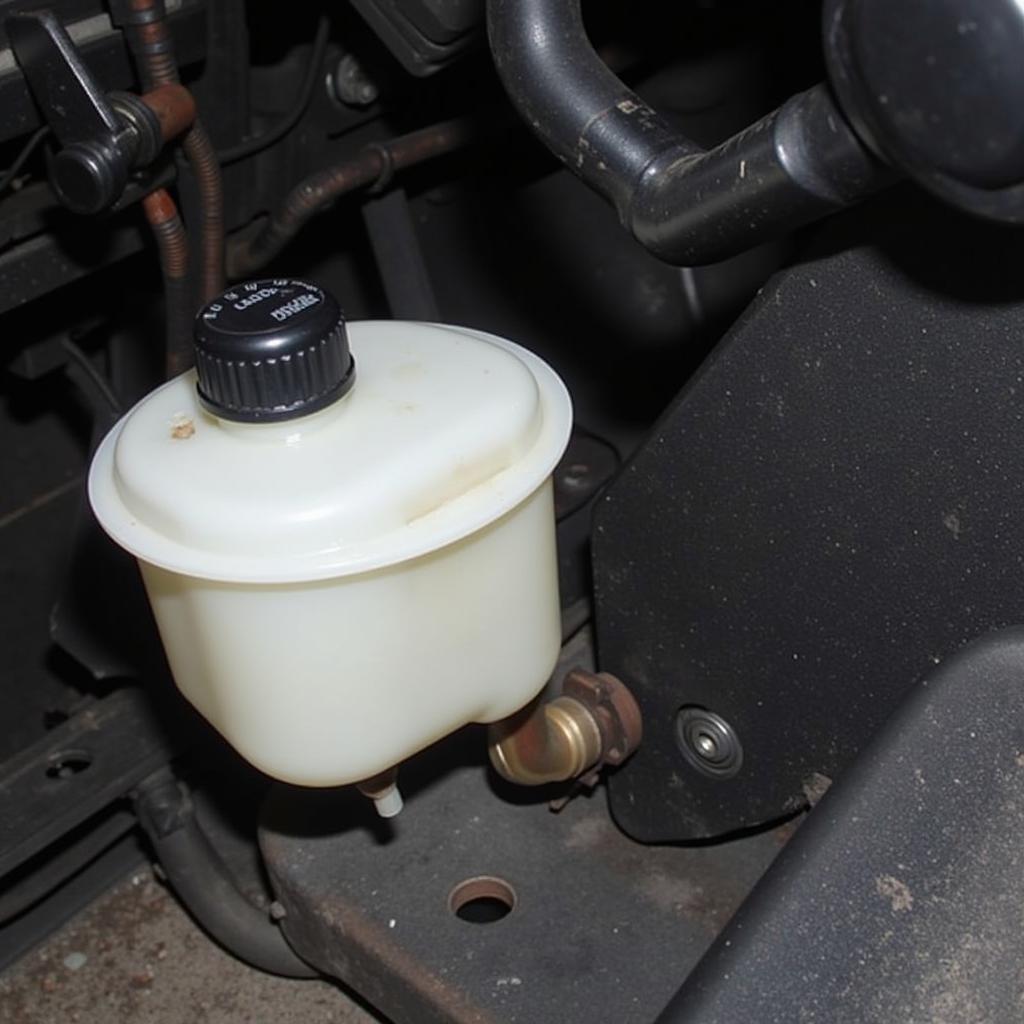The dreaded brake warning light. Few things are more disconcerting than seeing this persistent glow on your Ford F-150’s dashboard. If your F-150 brake warning light stays on, it signals a potential problem within your braking system that requires immediate attention. This article provides a comprehensive guide to diagnosing and addressing this issue, covering common causes, troubleshooting steps, and potential solutions.
Similar to the information found at f-150 brake warning light stays on, we’ll explore the various reasons why this light might illuminate and stay on.
Common Causes of a Persistent Brake Warning Light
Several factors can cause the brake warning light to remain illuminated in your Ford F-150. These include:
- Low Brake Fluid: This is the most frequent culprit. A leak in the brake lines, worn brake pads, or a faulty master cylinder can deplete brake fluid levels, triggering the warning light.
- Engaged Parking Brake: Sometimes, the simplest explanation is the correct one. Ensure your parking brake is fully disengaged.
- Faulty Brake Light Switch: This switch, located near the brake pedal, can malfunction and cause the warning light to stay on.
- ABS Issues: Problems with the Anti-lock Braking System (ABS), such as a malfunctioning sensor or pump, can trigger the brake warning light.
- Worn Brake Pads: Excessively worn brake pads can activate a sensor that illuminates the warning light.
Troubleshooting the Brake Warning Light
If your Ford F-150 brake warning light stays on, here’s a step-by-step troubleshooting guide:
- Check the Parking Brake: Make sure the parking brake is fully released.
- Inspect Brake Fluid Level: Open the hood and locate the brake fluid reservoir. Check the fluid level against the minimum and maximum markings. If it’s low, add the appropriate brake fluid.
- Check for Leaks: Carefully inspect the brake lines, calipers, and wheel cylinders for any signs of leakage. Look for wet spots or dripping fluid.
- Inspect Brake Pads: Examine the brake pads through the wheel spokes. If they appear thin or worn down to the metal backing plate, they need replacement.
As discussed in more detail on f150 brake warning light, diagnosing the issue early can prevent more serious problems down the road.
Solutions for a Persistent Brake Warning Light
Based on your troubleshooting, here are some potential solutions:
- Add Brake Fluid: If the fluid is low, top it off with the correct type specified in your owner’s manual. If the level continues to drop, you likely have a leak requiring professional attention.
- Replace Brake Pads: Worn brake pads must be replaced immediately. This is a relatively simple job that you can do yourself or have a mechanic perform.
- Repair or Replace Brake Components: If you identify a leak, the affected component (brake line, caliper, wheel cylinder, master cylinder) needs repair or replacement. This usually requires a professional mechanic.
- Address ABS Issues: Diagnosing and repairing ABS problems often requires specialized diagnostic equipment. It’s best to take your F-150 to a qualified mechanic for this type of repair.
- Check Brake Light Switch: If all other components seem fine, the brake light switch may be faulty. Replacing this switch is typically a straightforward procedure.
You can find specific instructions for certain models, like the 2013 F-150, on resources like 2013 f150 how to install warnings switch for park brake.
When to Seek Professional Help
While some brake-related issues can be resolved with simple DIY fixes, others require professional expertise. If you’re uncomfortable working on your brakes, or if the problem persists after attempting basic troubleshooting, it’s crucial to consult a qualified mechanic.
“Ignoring a persistent brake warning light can lead to significant safety risks,” says automotive expert John Smith, ASE Certified Master Technician. “Addressing the problem promptly can prevent more extensive and costly repairs down the road.”
Conclusion
A persistent brake warning light on your Ford F-150 shouldn’t be ignored. By understanding the common causes, following the troubleshooting steps, and considering the potential solutions outlined in this article, you can effectively address the issue and ensure the safety and reliability of your vehicle. Remember, if you’re unsure about any aspect of brake repair, consult a qualified mechanic. Don’t delay addressing this critical safety concern related to your Ford F-150 brake warning light stays on.
Just like the advice given on 2004 ford f 150 brake warning light fix, seeking professional help is crucial when necessary.
FAQ
- What is the most common reason for the Ford F-150 brake warning light to stay on? Low brake fluid is typically the most frequent cause.
- Can I drive my F-150 if the brake warning light is on? It’s not recommended. A persistent brake warning light indicates a potential problem with your braking system, which could compromise your safety.
- How do I check my brake fluid level? Locate the brake fluid reservoir under the hood and check the fluid level against the minimum and maximum markings.
- What should I do if my brake fluid is low? Add the correct type of brake fluid as specified in your owner’s manual. If the level continues to drop, you likely have a leak and should seek professional help.
- How often should I replace my brake pads? Brake pad lifespan varies depending on driving habits and conditions. It’s best to have them inspected regularly by a mechanic.
- What is the ABS system, and why might it cause the brake warning light to come on? The ABS (Anti-lock Braking System) prevents wheel lockup during hard braking. A malfunctioning sensor or pump within the ABS can trigger the warning light.
- How much does it typically cost to fix a brake warning light issue? The cost varies depending on the underlying cause and the necessary repairs. It could range from a simple top-off of brake fluid (minimal cost) to a more complex repair like replacing the master cylinder (more expensive). Consult a mechanic for a specific estimate.


